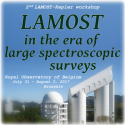Speaker
Dr
Haining Li
(NAOC)
Description
Surveys of very metal-poor (VMP) stars and follow-up spectroscopic studies for them in the past decade have provided with abundant information on the nature of first stars and early chemical evolution of the Milky Way. LAMOST will soon accomplish its first 5-year spectroscopic survey, and has already observed over 6 million Galactic stars. Such huge database will provide an unprecedented chance to enlarge the currently limited VMP star sample. In 2013, we started to obtain follow-up high-resolution spectroscopy for candidate VMP stars selected from LAMOST database. So far, the project has obtained a success rate of >90% in searching for VMP stars, resulting in chemical abundances for about 230 VMP stars including more than 70 EMP stars and a number of chemically interesting objects such as: (1) Three UMP (ultra metal-poor) stars with [Fe/H] ~ -4.0. One of them is the second UMP turnoff star with Li detection. (2) A dozen Li-rich VMP/EMP stars, including six super Li-rich (A(Li) > +3) stars. They distribute in wide range of evolutionary stage and metallicity (-3.1 < [Fe/H] < -1.7). (3) Other peculiar VMP/EMP stars including r-process enhanced stars, etc. The follow-up project has also observed a number of member stars of halo moving groups and low-alpha abundance halo stars, which would shed light on the merging history of our Galaxy. Statistics of the large sample of VMP stars, together with abundance patterns of these peculiar objects, will be of great interest and importance to probe the early Galaxy and low-mass star evolution with very low metallicities.
Primary author
Dr
Haining Li
(NAOC)

